|
|
|
|
|
Orange, New South Wales, Australia - 1st August 2008
By: sararingham
I have arrived in Australia! Sure is cold here - crazy since it's Summer in many other parts of the world!
|
|
 Posted Aug 7, 2008, 8:06 am
[Quote] [View just this post] Posted Aug 7, 2008, 8:06 am
[Quote] [View just this post]

|
|
|
Orange, New South Wales, Australia - 4th August 2008
By: sararingham
Well today was a big day, we got some mystery shops done with Sara - which wasn't really picture worthy, but when we came home we helped Sara make a cake... I wonder why? Well Sara wasn't thinking and didn't remember to take photos, but instead we got to decorate the cake... although we didn't have much we used some gummy worms and spelled out "Dan" which is her husbands name...
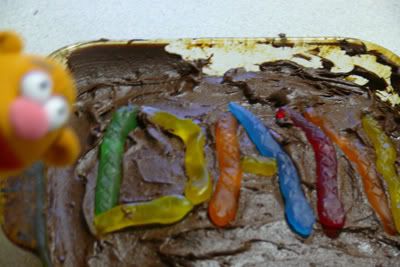
So we finally figured it out - it must be Daniel's birthday! Happy Birthday Daniel! The cake was SO yummy!
|
|
 Posted Aug 7, 2008, 8:34 am
[Quote] [View just this post] Posted Aug 7, 2008, 8:34 am
[Quote] [View just this post]

|
|
|
Bathurst, New South Wales, Australia - 6th August 2008
By: sararingham
Today was a very busy day... we got woken up very early and got in the car - we were on our way to Bathurst. We had four mystery shops to do, again, not really picture worthy so no photos were taken of that... but for us waiting in the car to not get lost we got a bit of a treat. We got to visit the famous Mount Panorama... a very famous race track that is used throughout the year, but you can drive on it and many people do drive on it to get to their homes (as a shortcut). During October it's EXTREMELY busy as the races are in the beginning of October. They're already preparing for the races, and it's only August...
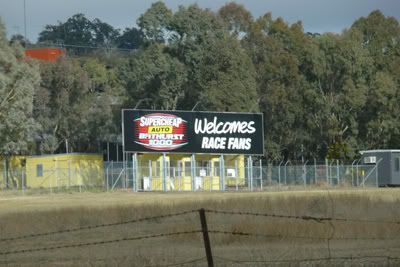
...here I am standing at the famous sign that's on the side of the 'mountain'...
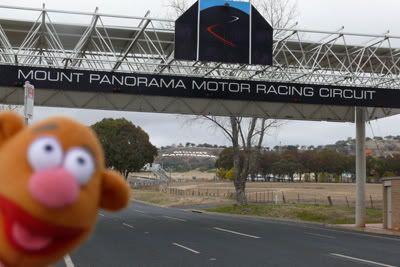
...and here's a close up of the famous sign...
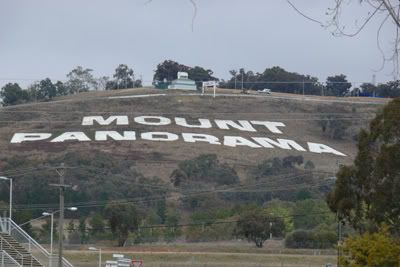
...here is some information about the track, a sign showing what the track looks like - and then a bit of information about the race track...

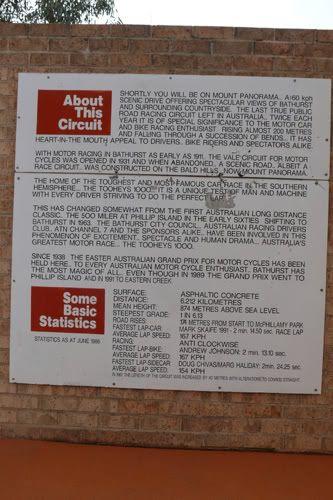
...and now it's time to get on the track, we drove around it counter-clockwise which is the same direction as the v8 cars that drive around it... now here's a whole bunch of photos as we are going around the track. :-)
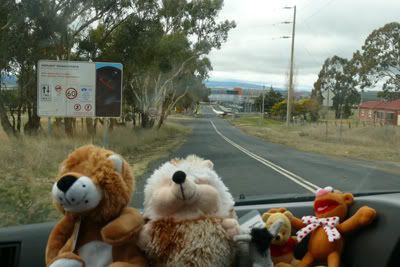
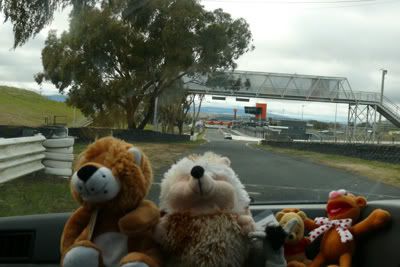
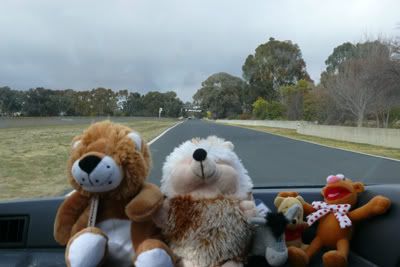
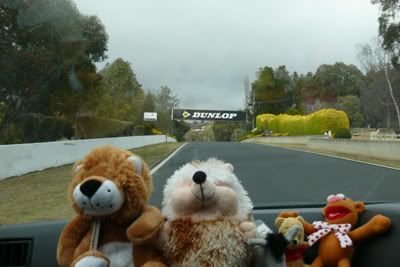
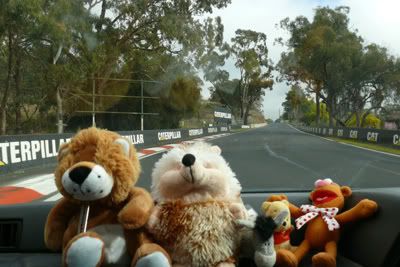


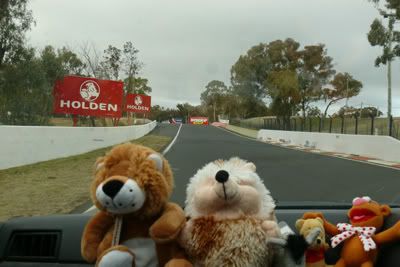

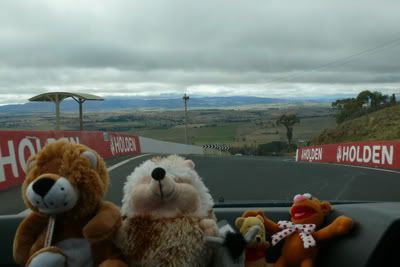

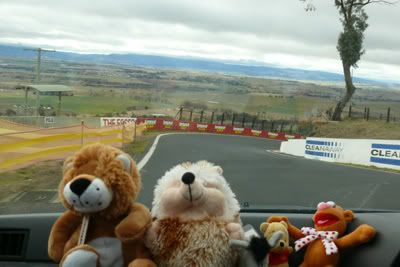
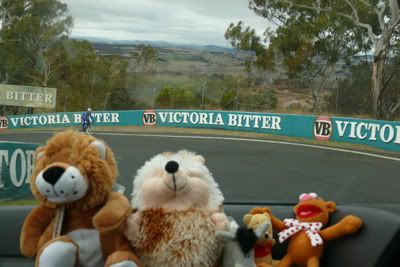
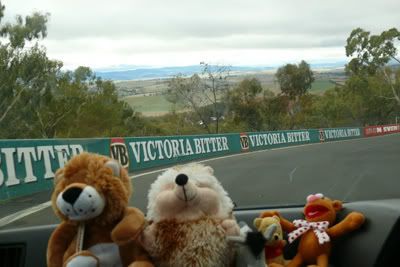
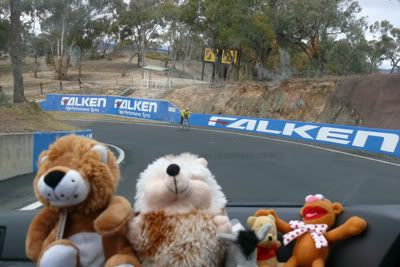

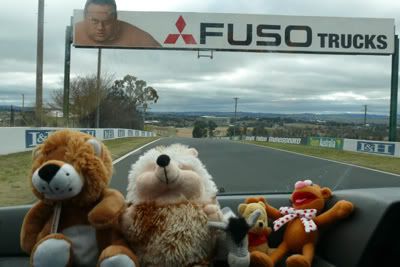
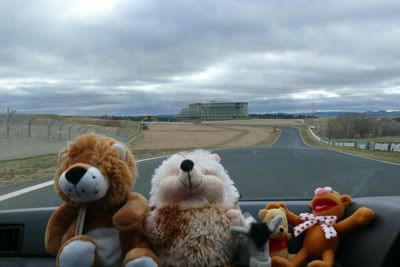
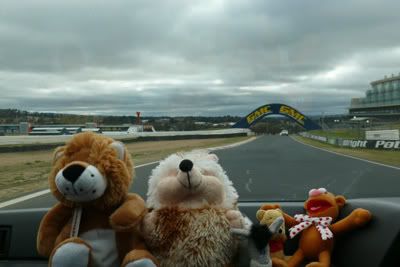
...and as were coming back around here's the starting gate...
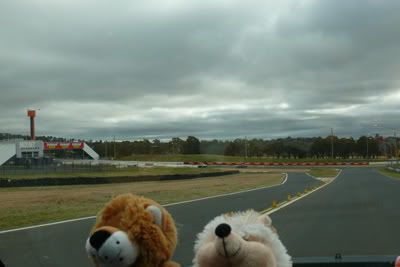
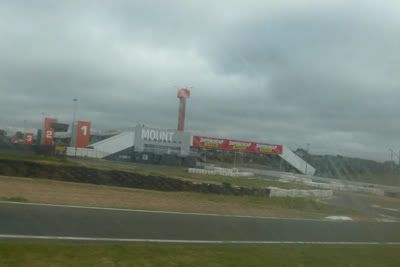
...and here's what you see as you're leaving the race track. :-) As you can probably tell there is a lot of people that drive around the track, it seems like a big reason to come to the Central West... anytime but race time... race time it's extremely busy, even in Orange - which is around 55kms drive from Bathurst... and even farther than that...
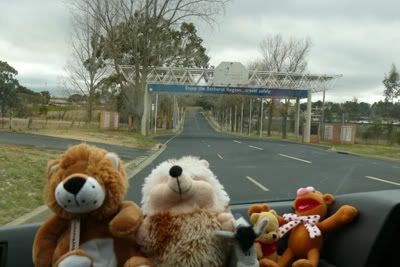
...now it's time to get all the stuff done... here's William Street the main street of Bathurst as were about to go down it, as you can see it looks like a small town but it's actually got around 40,000 or so people in it - so definitely not a city but a nice little "country town".
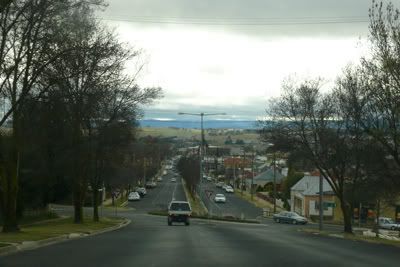
...after we were done doing all the mystery shops we pulled over quite suddenly, I wonder why? Well... of course Sara decided to pull over and show us a famous Australian sight... kangaroos...
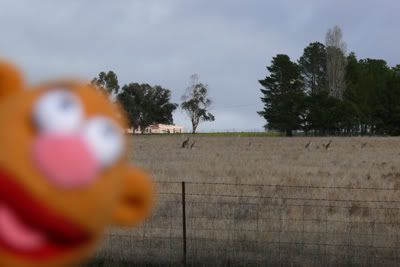
...as you can see them in the background we had to keep our distance but Sara got a lot closer and got some better shots of them for us... :-)
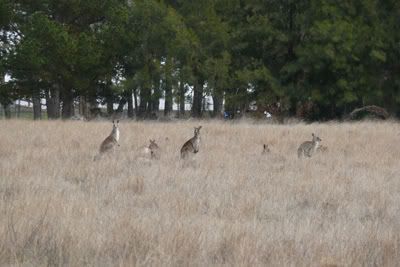
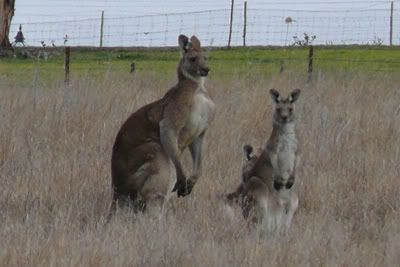
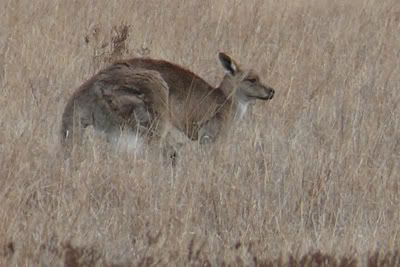
Well I hope you enjoyed our trip to Bathurst! It was quite exciting - we're going back next Friday - and were going to visit the fossil museum, Sara's been itching to visit it for quite some time... I'll write again soon... :-)
|
|
 Posted Aug 7, 2008, 9:29 am Last edited Aug 7, 2008, 9:32 am by sararingham
[Quote] [View just this post] Posted Aug 7, 2008, 9:29 am Last edited Aug 7, 2008, 9:32 am by sararingham
[Quote] [View just this post]

|
|
|
|
|
Wellington, New South Wales, Australia - 13th August 2008
By: sararingham
Today was a big day, Sara didn't tell us where we were going but it was sure cold outside so we were so glad to get into the car... even Toothy Walrus came with us today, so that was pretty exciting for us! First stop was Wellington, which is around an hour West from Orange... it's a small town around the size of a lot of the smaller towns that surround Orange and Bathurst, and it's got the famous Wellington Caves. Sara's been in there once before, she said that it was sure pretty... here's us in the main street of Wellington...
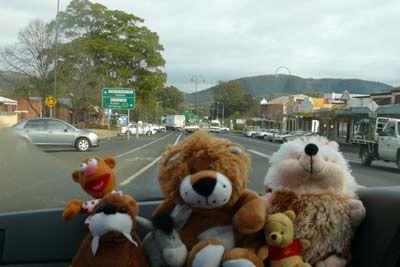
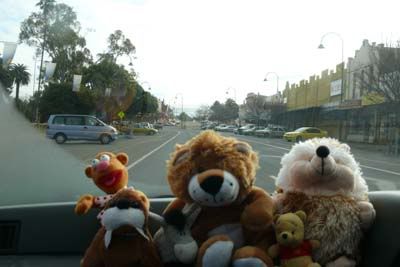
Back onto the road... watch for a big update soon!...
|
|
 Posted Aug 14, 2008, 11:55 am
[Quote] [View just this post] Posted Aug 14, 2008, 11:55 am
[Quote] [View just this post]

|
|
|
Dubbo, New South Wales, Australia - 13th August 2008
By: sararingham
Next stop was Dubbo...
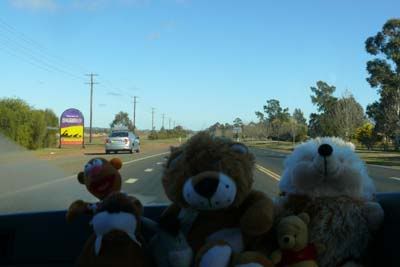
We all were sure happy to stand up for the first time in 2-1/2 hours our legs were sure tired from sitting that long. We stopped, did two mystery shops, and then was off to do the thing we were set off to doing. We first stopped at Red Rooster and got something to eat and headed off. A very short drive later we were there... the entry looked like the entrance to Jurassic Park and then Sara told us it's Taronga's Western Plains Zoo. She told us that this zoo has a climate very similar to the African climate so they breed endangered animals... this zoo is so big that you drive through most of it, park get out an see the animals, walk on trails and everything. Sara said the zoo is over a 6 kilometre radius, so there's LOTS of room for the animals to walk around...
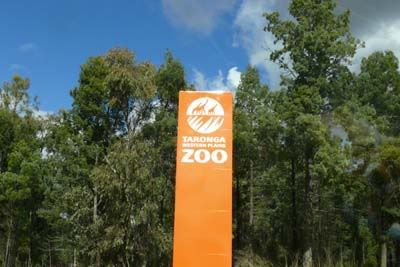
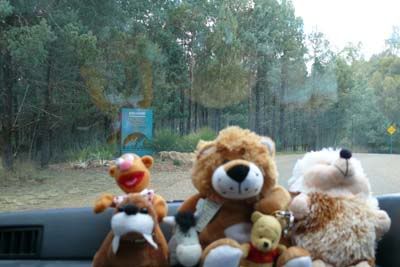
First thing we see when we get into the main part of the zoo are the African Wild Dogs there was only two in the exhibit as the sign said that they were currently introducing a female to the pack. They were quite active and running around at the back of the exhibit so it was hard to get myself in a photo with them.

You'll find most of the animals in the zoo aren't close it doesn't look good for me to be in the photo as I'll be just a blurred mess but it was still an amazing adventure... before we moved onto the next animal we decided to have a look around one of the huge ponds they had throughout the zoo... there was some Australian white ibises there, Sara took a photo as there were masses of them - they weren't part of the zoo, but they obviously liked their living quarters...

It's common to find these guys all over the place including the dump, all over Sydney... they're known like pigeons are known throughout the world... but much bigger...
The next animals were the Arabian Camel and the Barbary Sheep. They were both in the same enclosure. You could see the camels straight away, but there was no Barbary Sheep, hmmm... I wonder where they could be...G]
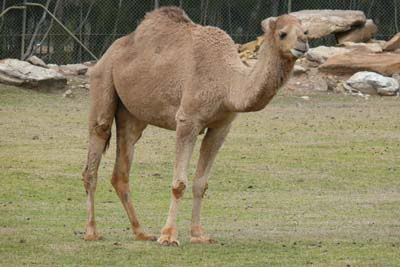
...then we had a closer look at the other side of the enclosure and we noticed they were in the rocky area... how strange, they blended in SO well I could barely notice them... Sara had to zoom all the way in on her camera to get this photo... as we went back to the car they all stood up and were walking around... Sara got some more photos, but there's so much to get to already we moved on...
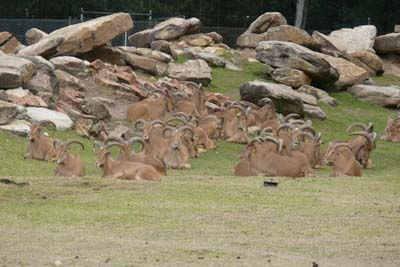
Sara took a few photos of some of the signs for you to read if you wanted to... the Arabian Camel sign says:
Life In The Desert... Camels are well suited to life in the desert. By producing dry faeces and very little urine or sweat, they can survive for a long time without water. When good food is available camels store fat in their hump. When food is scarce, they use this as an energy supply. They will also eat thorns, dry vegetation and saltbush that other animals avoid.
Life In Australia... Camels were introduced to Australia in the 1840's to carry heavy loads and passengers into the dry heat of the country. Many survived and are now in higher numbers in the Australian desert than in the wilds of Arabia. There are no known wild Arabian Camels left.
The Arabian Camel's wild ancestor is unknown - it is presumed to be extinct.
The sign for the Barbary Sheep reads:
Barbary Sheep are the only wild sheep that live in Africa. They are an important source of meat which is valuable to the desert economy. In some areas, their numbers have dropped so low that they are now considered vulnerable.
Rocky hills, mountains and stony plains don't offer much protection from predators so Barbary Sheep rely on camouflage. If threatened they stand still and their sandy colour coat blends with the desert habitat. Their hooves have soft centre pads with hard-rimmed edges that can grip any ledge - great for scampering up sheer cliffs.
Whilst we were watching the animals we saw some Australian birds, Sara got a photo of some of them as some of them are very pretty unique birds known to Australia... first we saw the Grass Parrot, they're very pretty...
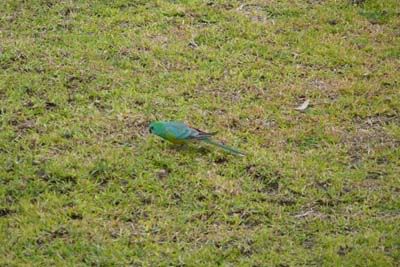
...and then near the parrot we saw two Crested Brozewing's which are Australia's native pigeon... Sara has some she feeds in her yard all the time... they're quite pretty for pigeons I think. :-)

Onto the next animal, this animal was something that is unique to Australia, the only Australian zoo known to have them and breeds them... the critically endangered Black Rhino...

...the next animal it was quite exciting as you see when we were driving up they were all quite close as they were eating so Sara was able to get some really nice close up shots... here are the Giraffes.
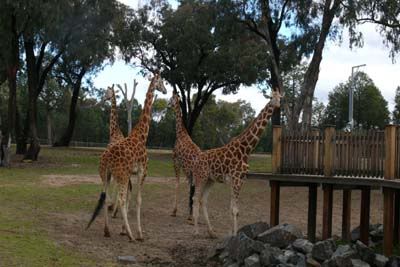
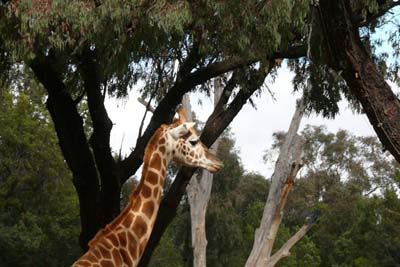
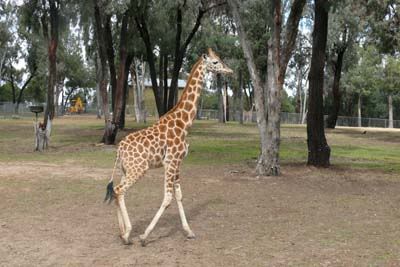
Once we watched the giraffes for a while and they all moved on we went to the next stop, the African Elephants... they also were eating, some branches... how strange is that? There was one there that was HUGE... Daniel was saying how the one closest to us, and in most of the photos was one of the oldest in Australia. He was lucky enough to be able to feed him a few years back...



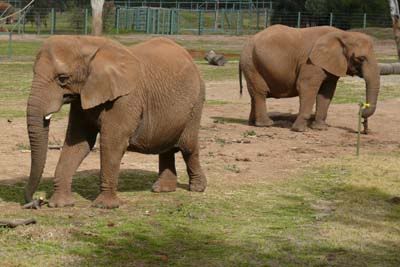
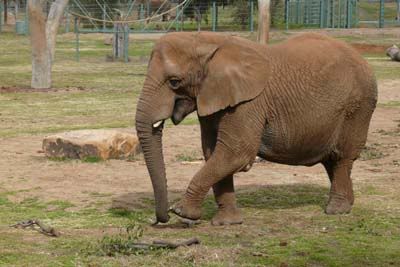
We next stopped at the White Rhinos which are almost threatened, but no where near extinction like the Black Rhino... there were quite a few there, and even a baby, in the way back lying down... so cute!...
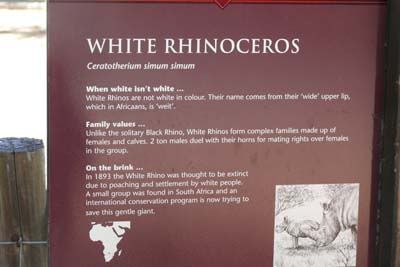
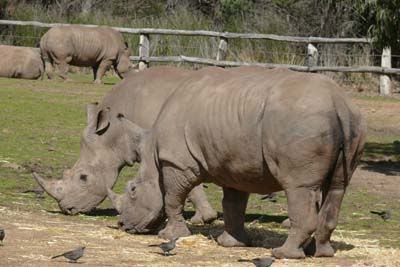
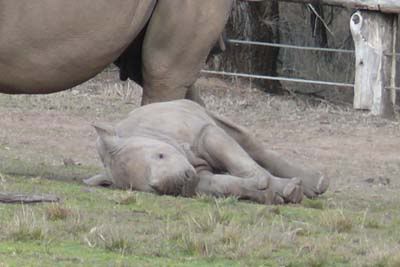
Here's what the sign for the white rhino says...
When white isn't white... White Rhinos are not white in color. Their name comes from their 'wide' upper lip, which in Africaans, is 'weit'.
Family Values... Unlike the solitary Black Rhino, White Rhinos form complex families made up of females and calves. 2 ton males duel with their horns for mating rights over females in the group.
On the brink... In 1893 the White Rhino was thought to be extinct due to poaching and settlement by white people. A small group was found in South Africa and an international conservation program is now trying to save this gentle giant.
I quickly turned around noticing these birds seemed to be following us all throughout the zoo, they must want some food, sadly I didn't have any food to give them but he was happy to pose for a photo, I thought they were quite nice looking birds... kind of had an eagle appearance with the bone structure...
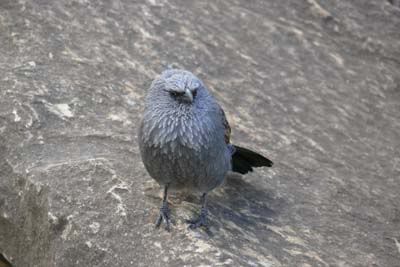
Right across from the White Rhinos we visited some more water animals, although these guys weren't active at all when we were visiting them they were the Common Hippopotamus...

...once we left though they actually became quite active and were swimming around and making growling type noises, sadly Sara wasn't able to get any more photos beyond this one of the hippo... they seemed to dive a lot when Sara went to take a photo... I guess they didn't want their photo taken... oh well...
...as we were about to go to the next animal... we heard this really loud screeching noise, we went to investigate... after a lot longer of a walk than we thought it would be we ended up at the Siamang Primates there was a family of three there and they were making such noise... but they were quite funny, and it grew quite a large crowd as well!...
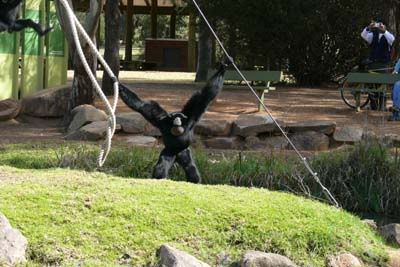
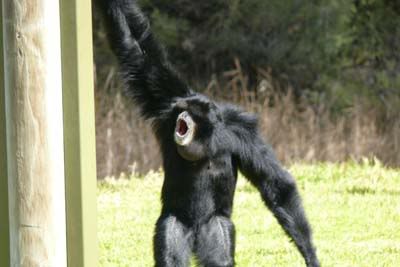
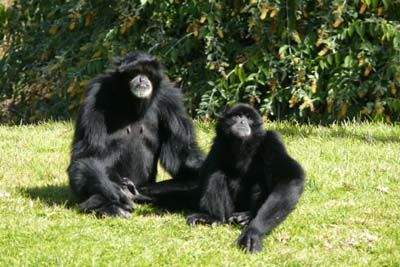
...we could hear them across the zoo the rest of the time we were visiting the zoo too - pretty fun to watch!...
On the way back from visiting the noisy monkeys we saw some more calm monkeys that didn't quite have a crowd, like at all... so we decided to watch them for a little while, they were the White Handed Gibbon...
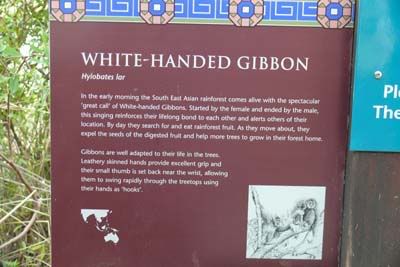
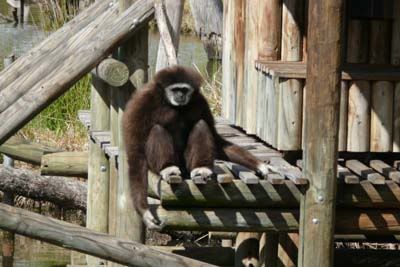
The sign for the white-handed gibbon says:
In the early morning the South East Asian rainforest comes alive with the spectacular 'great call' of the white-handed gibbons. Started by the female and ended by the male, this singing reinforces their lifelong bond to each other and alerts others of their location. By day they search for and eat rainforest fruit. As they move about, they expel the seeds of the digested fruit and help more trees to grow in their forest home.
Gibbons are well adapted to their life in the trees. Leathery skinned hands provide excellent grip and their small thumb is set back near the wrist, allowing them to swing rapidly through the treetops using their hands as 'hooks'.
...next stop before finally going back to the car we saw some Ruffed Lemur... these guys were quite playful, especially when the zoo keepers came in to feed them and clean out their enclosure, it was pretty cute to watch...
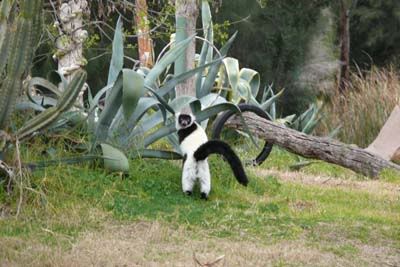
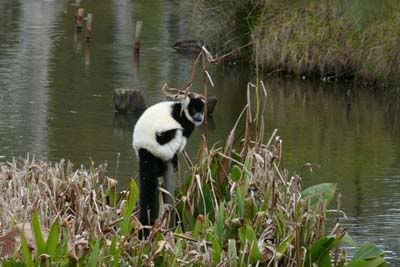
As we were coming back to what we originally intended to see next we saw another Australian native bird... it's called a Willy Wagtail they're cute little birds that look like they're wearing a tuxedo...
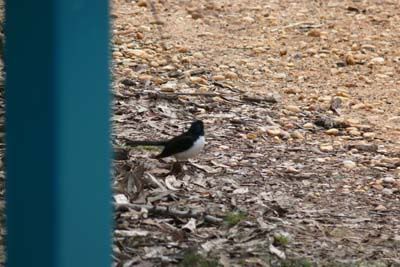
...finally back on track again, the next animal is known as the largest antelope in the world, it's called the Common Eland...
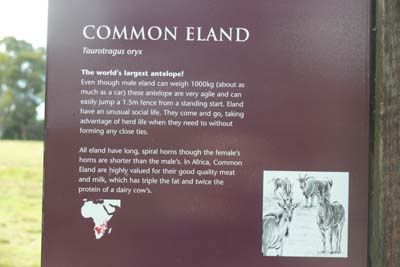
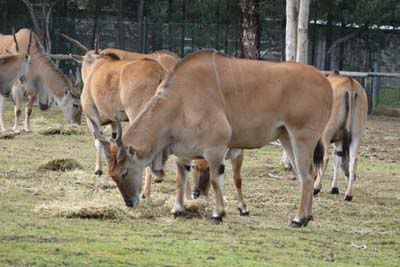
The common eland sign reads:
The world's largest antelope! Even though male eland can weight 1000kg (about as much as a car) these antelope are very agile an can easily jump a 1.5m fence from a standing start. Eland have an unusual social life. They come and go, taking advantage of herd life when they need to without forming any close ties.
All eland have long, spiral horns though the females horns are shorter than the male's. In Africa, common eland are highly valued for their good quality meat and milk, which has triple the fat an twice the protein of a darily cow's.
...time to move onto the next animal... this just happened to be the fastest land animal in the world... the Cheetah... fast? really? all these guys were doing was lounging around... they looked pretty happy though!
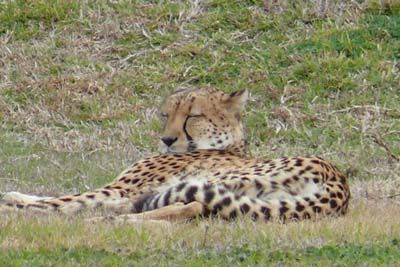
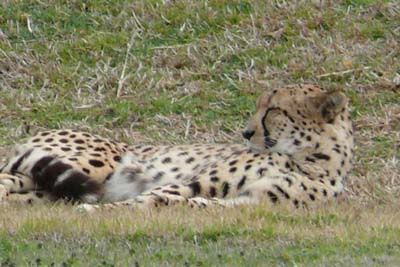
We turned around and took another little walk down another trail towards the centre of the zoo when we came upon the strange looking Bongo's... although the animals so far have been pretty good at posing for the photos, these guys wanted nothing of it... it was very hard to get a photo with them looking at us... they must be pretty stubborn little (or not so little) guys!
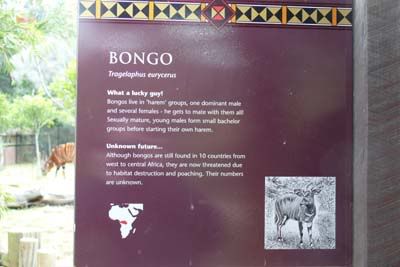
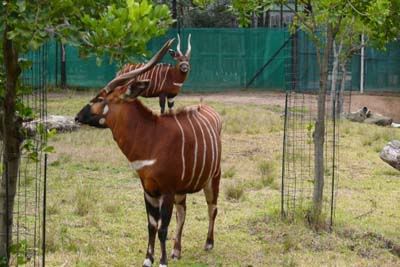
Here's what the bongo sign reads:
What a lucky guy! Bongos live in 'harem' groups, one dominant male and several females - he gets to mate with them all! Sexually mature, young males form small bachelor groups before starting their own harem.
Unknown future... although bongos are still found in 10 countries from west to central Africa, they are now threatened due to habitat destruction and poaching. Their numbers are unknown.
Whoops... it was about time to go to the front desk to ask a few questions so we did a quick run through the rest of the zoo before going back through... but on the way through we stopped and visited some more animals... the stay wasn't as long for the rest of the animals for the time being though...
So on the way there the first stop we made was for the Fallow Deer it was amazing how small they were... they even had the spots like a baby deer in America has... how cute!...
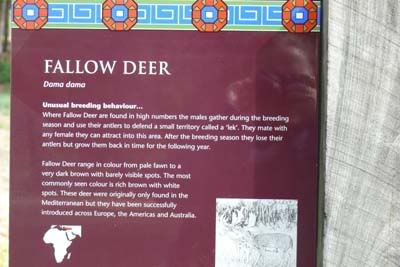
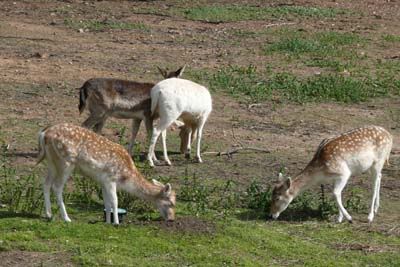
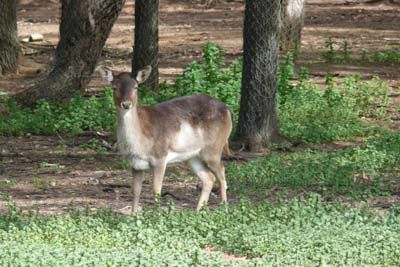
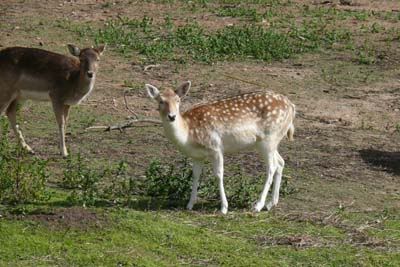
The fallow deer sign says:
Unusual breeding behavior... where fallow deer are found in high numbers the males gather during the breeding season and use their antlers to defend a small territory called a 'lek'. They mate with any female they can attract into this area. After the breeding season they lose their antlers but grow them back in time for the following year.
Fallow deer range in color from pale fawn to a very dark brown with barely visible spots. The most commonly seen color is rich brown with white spots. These deer were originally only found in the Mediterranean but they have been successfully introduced across Europe, the America's and Australia.
...We seemed to be in the hooved section of the zoo, as the next stop was the strange looking Persian Onager, they just looked like tan colored donkeys to me, but obviously they're quite different...

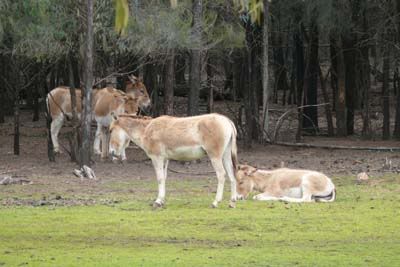
As the Persian Onager sign reads:
It's not a donkey... the Persian onager is the fastest member of the horse family. It is able to sustain a 50km/hr pace and is capable of short bursts at 70km/hr. In the flat, Iranian desert, herds of onager feed on grass and succulent plants. They travel long distances to reach feeding grounds in the winter and to find summer watering holes.
Modern firearms and competition with life stock for food and water have led to a decline in numbers in the wild. They are now only found in three desert regions where they have been protected for 30 years.
...next was the Asiatic Water Buffalo... Sara said that the last time they came through it was the middle of Summer and they were all crowded into the water, this time they were out of the water but were relaxing together eating... so still not extremely active, but it was amazing how huge they are!
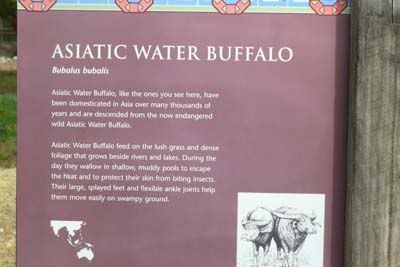

This is what the Water Buffalo sign reads:
Asiatic Water Buffalo, like the ones you see here, have been domesticated in Asia over many thousands of years and are descended from the new endangered wild Asiatic Water Buffalo.
Asiatic Water Buffalo feed on the lush grass and dense foliage that grows besides rivers and lakes. During the day they wallow in shallow, muddy pools to escape the heat and to protect their skin from biting insects. Their large splayed feet and flexible ankle joins help them move easily on swampy ground.
...as we were nearing the end of the hooved animals we had a visit with some Sambar and Banteng. There wasn't many to be seen but I got both of them in the same photo, the one near the front, the larger one is a Banteng and the one towards the back is the Sambar... here's some information about them...

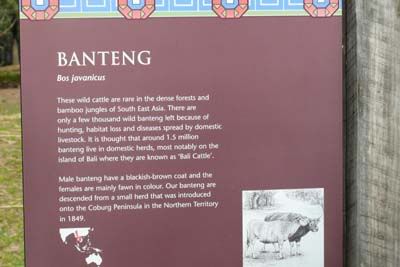
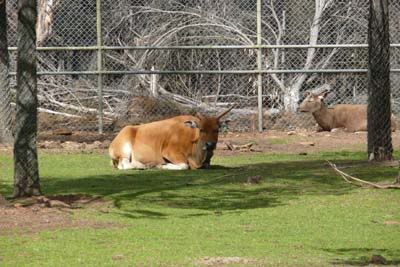
Here's what the Sambar sign says:
Raising the alarm... when alarmed, Sambar signal to other deer by stamping their front feet and raising their tails to show the white underside and rump. These large, woodland deer also make a 'belling' call when they sense a predator. They are partial to water and are often found bathing and feeding in lakes, rivers and marshes.
Male sambar grow and shed their antlers each year. They can grow up to a meter long in less than 5 months! They recognize each others antlers as a signal of strength - bigger antlers signal a stronger individual. Usually, a male sambar won't compete for females with another male whose antlers are larger than his.
...and the Banteng sign says:
These wild cattle are rare in the dense forests and bamboo jungles of South East Asia. There are only a few thousand wild banteng left because of hunting, habitat loss and diseases spread by domestic life stock. It is thought that around 1.5 million banteng live in domestic herds, most notably on the island of Bali where they are known as 'Bali Cattle'.
Male banteng have a blackish-brown coat and the females are mainly fawn in color. Our banteng are descended from a small herd that was introduced into the Coburg Peninsula in the Northern Territory in 1849.
...next stop was the famous Australian animal, the Emu... we all got a photo with them...
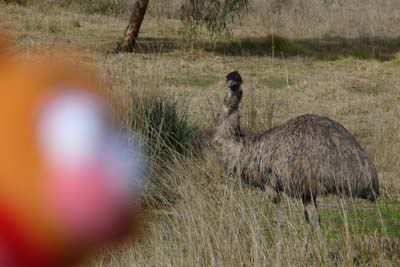
...and here's a better photo of one of the emu's, they're quite big birds... and we actually have them wild in the area where I'm staying with Sara although not very common they have been seen in farmers paddocks...

...whoa it's coming much closer to 2pm than I thought it was... we gotta get off to the information desk... when we got there... there was a peacock...

...kind of startled us all as we weren't expecting it... we then realised that what we were going to the information desk for was canceled for today... which was very sad...
...So instead we took a break and ate something then continued on... where we sat down to eat our lunch were some more crazy animals... some [url=http://en.wikipedia.org/wiki/Ring_tailed_lemur]Ring-Tailed Lemur's... they were all grouped up and we were pretty close them actually only a bit of water separated us from them...
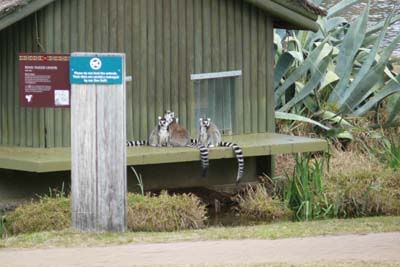
...well that wasn't all for the day we were only around half way through the zoo, but sadly Sara's memory card needed to be changed to a much larger one... so we didn't get anymore photos able to be uploaded for today... watch for an update in the near future with lots more Australian animals... this was quite a fun day today. I can't wait to tell you all about the rest of it! Write again soon!
|
|
 Posted Aug 14, 2008, 1:46 pm
[Quote] [View just this post] Posted Aug 14, 2008, 1:46 pm
[Quote] [View just this post]

|
|
|
Dubbo, New South Wales, Australia - 13th August 2008
By: sararingham
...continuing on with the last zoo post, I finally got the photos back... here's a better picture of the Ring-Tailed Lemur's they all seemed pretty cold as they all cuddled up together, aren't they cute?
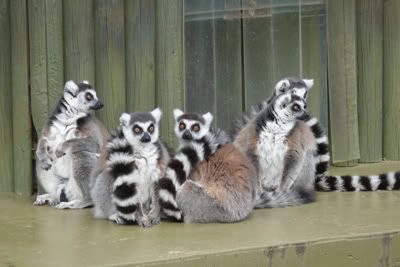
...finally we were back to going through the zoo, we started back off at the beginning and stopped at the animals we hadn't yet visited, revisiting a few as the animals were being fed when we came through the second time... next stop was the African Lion after quite a bit of time of waiting something down the hill got their attention and I got some pretty good shots of the male and one of the two lionesses...
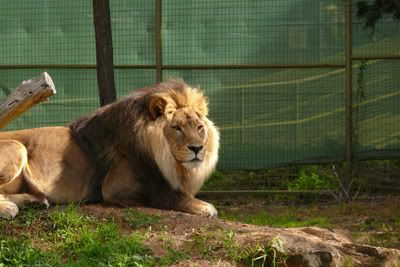
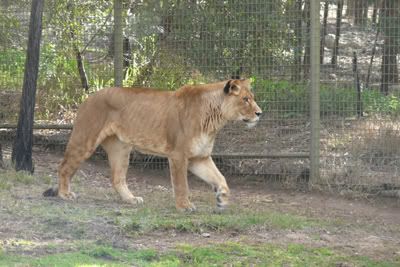
Then we got back down the hill and saw some African Plains Zebra's... funny enough when Sara took this photo the person feeding the animals stopped and gave them their food, one of the zebras ran right up to Sara thinking she was the zookeeper feeding her, then moved onto the zookeeper. Pretty cool. :-)

...we saw these in the earlier post... these are the Sambar Deer deer you saw far in the back of the photo, they were coming up to be fed as well, the antlers on the male were HUGE... very pretty!...
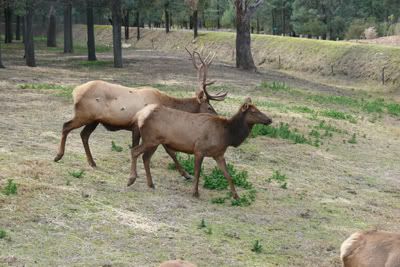
...next stop again was the Fallow_Deer... they were also being fed... they also came quite close... a few of them even rammed each other it must have been some kind of dominance thing within the herd...
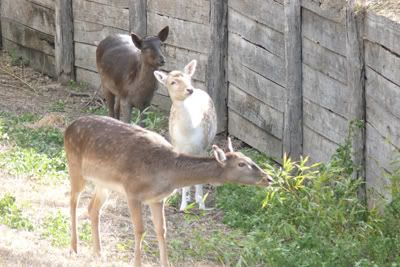
...back into the car, it was another short drive there was the Spotted Deer (Chital Deer)'s they were so far away... like in the very back of the pen, Sara had to zoom in all the way which was around 12x to get them, and a bit farther again to see them a closely as these photos... they were all in a group, huddled together... :-)

Then we got back in the car, time to move onto the next area of the zoo... then we got out and seemed to walk for what seemed like forever in what seemed like circles, then we encountered the rare Greater One-Horned Rhino...
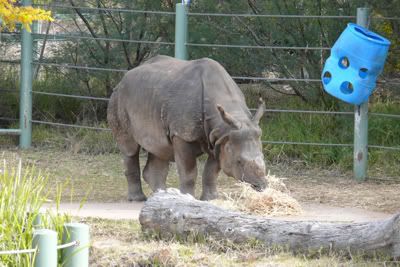
This endangered rhino is known as 'Dora', and the breed is known as a great success story, and here's a sign about the success story of this one-horned rhino...

...because it's so small I'll type out what it says...
A Great Success Story
Greater One-horned Rhino numbers have increased over the last century. However, poaching remains a critical issue and success is dependent on continued and increased support for conservation efforts in India and Nepal.
Pre-1600 - Greater One-horned rhino common in the wild.
Early 1600's - Early 1900's - Loss of Greater One-horned Rhino's habitat as floodplain grasslands used for agriculture.
Late 1800's-Early 1900's - Sport hunting of rhino is popular.
1871-1907 - 207 Rhino's killed by one hunter.
Late 1880's-Early 1900's - Government bounty on Rhinos to stop destruction of tea plantations.
Early 1900's - Rhino near extinction, 12 left in India, 50 left in Nepal.
Late 1900's - Period of intense poaching (Rhino horn in 1972 worth $35.00/kg (USD) and in 1991 it was worth $50,000.00/kg (USD).
Late 1900's - Rhino's in Chitwan National Park, Nepal protected by 1,000 troops and rangers.
Now - Rhino numbers increased to 2,400. Local support for tourism industry increases funding for Rhino protection officers. Not all eggs in one basket - some Rhinos relocated from large groups to other protected areas, decreasing possible impact of local disasters.
That was extremely interesting to read that the one-horned rhino's went down to only 62 individual rhino's at one point, and now have been brought up to 2,400... still a lot more work to do, but still amazing none the less... a few years ago one of the rhino's was actually born within this zoo, it was shown internationally as it was an amazing thing... especially for a zoo to successfully breed this animal. :-)
Next stop was the Asian Small Clawed Otter... their were two in the enclosure and didn't seem to be too active at the time... but were very interested in watching us... no swimming for them while we were visiting though...

...Time then to go back to the car and get to the next animal, as the zoo was getting ready to close... whoops! Next stop was the American Bison they seemed happy and well fed, this was the only good shot I got before the moved onto the back of the enclosure...
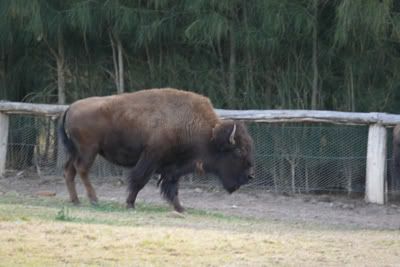
Now finally were in the Australian section of the zoo, first stop was quite exciting for Sara as she hadn't ever seen one, even in the zoo... the Dingo... they're not found in New South Wales as the sign reads below... and this one was actually quite cheeky, he was watching the people watching him and someone went to bring out their camera and the dog leaned forward and licked his lips... when the person said "no mate, I don't have food" and the dog sat back down and whimpered... it was pretty funny and cute...

Here's the information about the Dingo, and what it says:
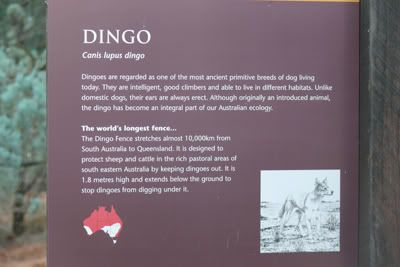
Dingoes are regarded as one of the most ancient primitive breeds of dog living today. They are intelligent, good climbers and able to live in different habitats. Unlike domestic dogs, their ears are always erect. Although originally an introduced animal, the dingo has become an integral part of our Australian ecology.
The world's longest fence... The dingo fence stretches almost 10,000km from South Australia to Queensland. It is designed to protect sheep and cattle in the rich pastoral areas of south eastern Australia by keeping dingoes out. It is 1.8 metres high and extends below the ground to stop dingoes from digging under it.
...the next stop we all had to get out of the car and walk up a big long boardwalk type thing, we were going up into the trees... I wonder what Australian animal we'll find up here... of course we found a few Koala's...

...here's a bit of information about this little guy, they seemed a bit wobbly an one of them almost fell out of the tree before catching himself... :-)
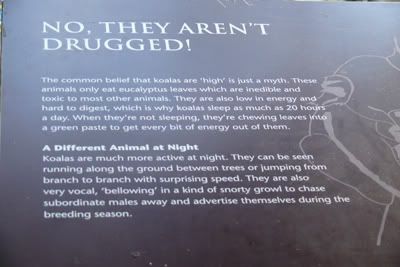
No, they aren't drugged! The common belief that koalas are "high" is just a myth. These animals only eat eucalyptus leaves with are inedible and toxic to most other animals. They are also low in energy and hard to digest, which is why koalas sleep as much as 20 hours a day. When they're not sleeping, they're chewing leaves into green paste to get every bit of energy out of them.
A different animal at night. Koalas are much more active at night. They can be seen running along the ground between trees or jumping from one branch with surprising speed. They are also very vocal, 'bellowing' in a kind of snorty growl to chase subordinate males away and advertise themselves during the breeding season.
...next stop was something I've seen in the wild... one not the other... there was the Red Kangaroo and the much more common Grey Kangaroo... there aren't as many red kangaroos in the area I'm staying... they're more common in this area (Dubbo and beyond)... they're also more common in Western Australia than Grey kangaroos are over there... Red kangaroos are the largest species of kangaroo, as you can see this guy is pretty huge!


...kangaroos are very interesting creatures... these animals can be pregnant, and then stop or slow down their pregnancy in the driest of times... and when the land is more fitting for the baby (especially during the wet season) the baby will continue with the pregnancy that way the baby can flourish during this time and not die because of the extreme droughts that Australia goes through...
...time to move onto the next animal... another species of kangaroo, a smaller species called the Yellow Footed Rock Wallaby... there was actually two types of kangaroo in this enclosure but the other wasn't seen, it was called the Wallaroo which is surprisingly more common...
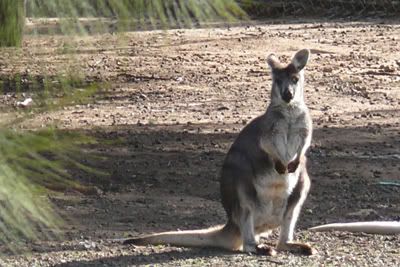
...here's some information about the Rock Wallaby and the Wallaroo...

The Yellow-footed Rock-wallaby lives on rocky outcrops in semi-arid Australia. Hunted for sport and it's beautiful coat this wallaby has become increasingly rare over the past 200 years. Introduced animals like rabbits and goats destroy its habitat and compete with the wallaby for food. Predation by cats and foxes has also reduced wallaby numbers in the wild.
Our Yellow-footed Rock-wallabies are part of a regional management program for this species. Wallabies from this program have been successfully reintroduced into an area of the Flinders Ranges in South Australia where their competitors and predators have been removed.
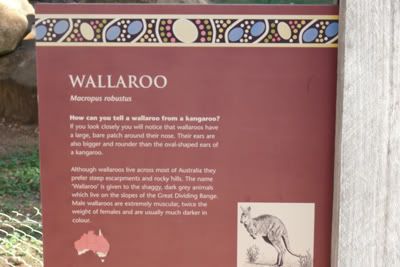
How can you tell a wallaroo from a kangaroo? If you look closely you will notice that wallaroos have a large, bare patch around their nose. Their ears are also bigger and rounder than the over-shaped ears of a kangaroo.
Although wallaroos live across most of Australia they prefer sheep escarpments and rocky hills. The name 'Wallaroo' is given to the shaggy, dark grey animals which live onthe slopes of the Great Dividing Range. Male wallaroos are extremely muscular, twice the weight of females and are usually more darker in colour.
Next stop again was another type of kangaroo... the Red-necked Wallaby... and the other type that's not pictured (because I didn't see it to get a photo of it) the Whiptail Wallaby... both are a bit uncommon, but after a bit of consideration I realised this photo is indeed of a red necked wallaby...
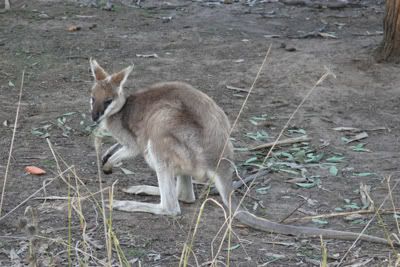
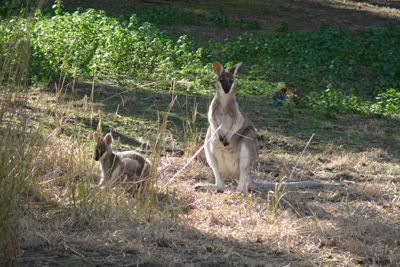
...and here's a bit of information about both species of wallaby... :-)
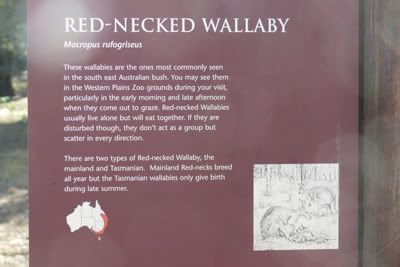
These wallabies are the ones most commonly seen in the south east Australian bush. You may see them in the Western Plains Zoo grounds during your visit, particularly in the early morning and late afternoon when they come out to graze. Red-necked wallabies usually live alone but will eat together. If they are disturbed though, they don't act as a group but scatter in every direction.
There are two types of red-necked wallaby, the mainland and Tasmanian. Mainland red-necks breed all year but the Tasmanian wallabies only give birth during late Summer.
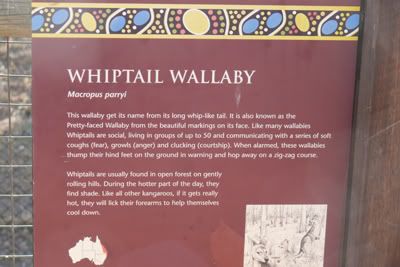
The wallaby gets its name from it's long whip-like tail. It is also known as the pretty-faced wallaby from the beautiful markings on it's face. Like many wallabies Whiptails are social, living in groups of up to 50 and communicating with a series of soft coughs (fear), growls (anger) and clucking (courtship). When alarmed, these wallabies thump their hind feet on the ground in warning and hop away on a zig-zag course.
Whiptails are usually found in open forest on gently rolling hills. During the hotter part of the day, they find shade. Like all other kangaroos, if it gets really hot, they will lick their forearms to help themselves cool down.
Next stop wasn't an Australian animal, we're done with the Australian section for the time being and now were visiting the endangered Galapagos Tortoise...
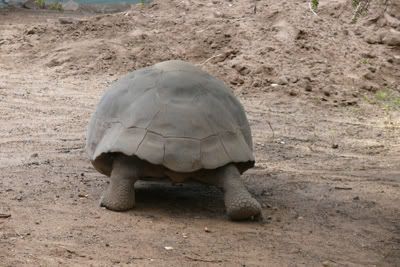
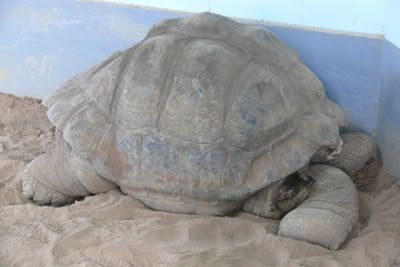
...the tortoise was walking away after she had finished eating, she was a tortoise that actually was born in the wild... she is currently 120 years old and there are two other tortoises... they were both asleep, as you can see in the second photo. Aren't they just amazing animals? They're trying to breed them in this zoo. :-)
Nearing the end of the zoo now, there are only a few more animals, and one large enclosure to visit... this enclosure had Brazilian Tapir's and Alpaca's....
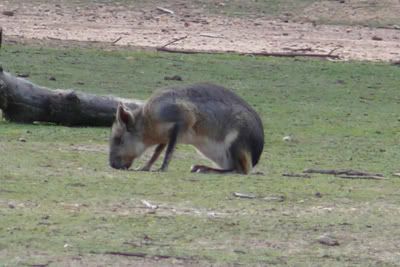

Here's a bit of information about both of the animals...

Is it a pig? Is it an anteater? No it's a tapir, which is most closely related to horses and rhinos. Tapir have a flexible nose which they use to grab forest plants and fruits and pull them into their mouths. They have a superb sence of smell and hearing and are mainly active at night.
Brazilian Tapirs live in lowland rainforest, always near water. They are excellent swimmers and are known to retreat into water if threatened. In the forest they create well trodden 'tapir trails', which connect their water sources, salt licks and feeding and sleeping areas. These well worn trails make them an easy target for hunters. They are also increasingly threatened by forest clearance.
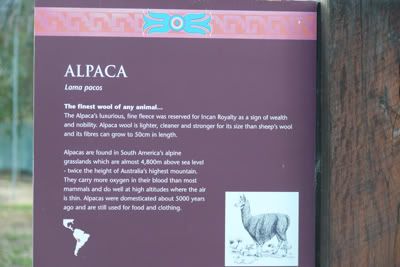
The finest wool of any animal... The alpaca's luxurious, fine fleece was reserved for Incan Royalty as a sign of wealth and nobility. Alpaca wool is lighter, cleaner and stronger for its size than sheep's wool and its fibres can grow to 50cms in length.
Alpacas are found in South America's alpine grasslands which are almost 4,800m above sea level - twice the height of Australia's highest mountain. They carry more oxygen in their blood than most mammals and do well at high altitudes where the air is thin. Alpacas were domesticated about 5,000 years ago and are still used for food and clothing.
This again was an area where you had to walk around a bit to find the area, these were smaller enclosures which fit just the amount of animals per enclosure, we stopped first to visit the Meerkats... they were all quite active... :-)

Onto the next enclosure we got to see two other Australian animals... the Common Wombat... Sara said she's seen only a few in the wild, they're common, but not as much in the area where Sara has been... they're quite large, and very solid...

Here's a bit of information about the Wombat...

Wombats have powerful claws and dig large burrows, up to 20 metres long, in which they stay cool during the heat of the day. They usually live alone except during the mating season. Like other burrowing marupials, the femal's pouch opens to the rear to help keep it clean.
Western Plains Zoo's Common Wombats are part of a successful breeding program. Zoo staff are researching wombat reproduction in specially designed 'off exhibit' enclosures. It is hoped this research will help us to learn more about the breeding behaviours of the critically endangered Hairy-Nosed Wombat.
Next enclosure was the Short-Beaked Echidna... he was quite friendly and came up to us, and actually let us "pet" him... although as you can imagine their not the type of animal to pet... we did though and we just were sure to pet him the right direction. :-) Sara was actually telling us about the fact that they live in the area where were staying (Orange) and how Daniel (Sara's husband) has actually stopped finding them on the side of the road and helping them cross the road. He also said never to let them in the car because when they're frightened they'll dig and tear up the inside of the car out of fear.

...and here's a bit of information about the short-beaked echidna...
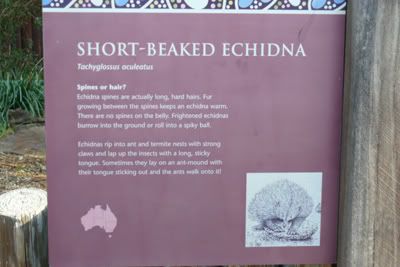
Spines or hair? Echidna spines are actually long, hard hairs. Fur growing between the spines keeps an echidna warm. There are no spines on the belly. Frightened echidnas burrow into the ground or roll into a spikey ball.
Echidnas rip into ant and termite nests with strong claws and lap up the insects with a long, sticky tongue. Sometimes they lay on an ant-mound with their tongue sticking out and the ants walk onto it!
...last stop was a huge aviary with a whole bunch of Australian native birds... we got one photo while we were in there which was the Diamond Firetail Finch...

Well, that was that, the zoo was closed and we were ready to head home... sadly no more photos as the battery had just died (good timing)... the drive home was long but we were all exhausted and ready to lay down at home... I hope you enjoyed my trip to the zoo!
|
|
 Posted Aug 28, 2008, 10:46 am
[Quote] [View just this post] Posted Aug 28, 2008, 10:46 am
[Quote] [View just this post]

|
|
|
|
|
Orange, New South Wales, Australia - 20th August 2008
By: sararingham
Today was a big day for Sara... it was her 26th birthday! We all got to celebrate with her... sadly none of the photos turned out with us in them so Sara just threw this one in... the cake was really yummy!
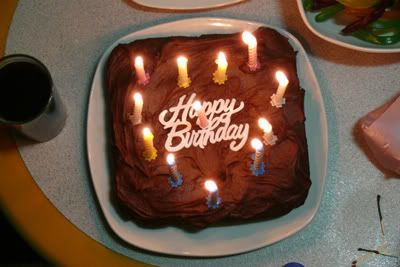
...Sara said I'll soon be moving onto my next host - I wonder where I'm going next!
|
|
 Posted Aug 24, 2008, 9:14 am
[Quote] [View just this post] Posted Aug 24, 2008, 9:14 am
[Quote] [View just this post]

|
|
|
Orange, New South Wales, Australia - 24th August 2008
By: sararingham
We haven't done much in the last week... we've said goodbye to some of our travel partners Misko and WinnieThePooh went to Sydney and Hermies is on his way to Arizona... maybe I'll meet up again with them one day?
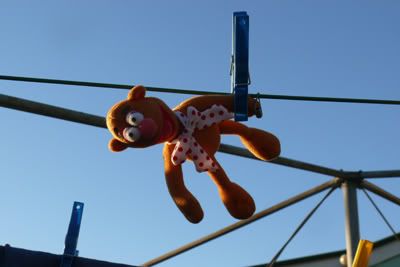
This weekend we just helped Sara with the laundry so we spent most of the time just hanging by on the line while Sara put the clothes up... we found we weren't much help because of how small and lightweight we are... oh well, it was nice and sunny so it was nice to be able to have a bit of time outside...
Tomorrow we're going to Blayney and I'm going to be sent onto my next host... :-) I wonder where I'm going, but I'm sure I'm going to have a lot of fun!
|
|
 Posted Aug 24, 2008, 9:35 am
[Quote] [View just this post] Posted Aug 24, 2008, 9:35 am
[Quote] [View just this post]

|
|
|
Orange, New South Wales, Australia - 27th August 2008
By: sararingham
After a nice long stay with me, Gucio was sent onto the next host today. He was quite excited to be getting into the padded bag to his next location... he just wonders where he'll pop out next! Thanks for being such a great visitor with me, and good luck on all your future journeys. :-)
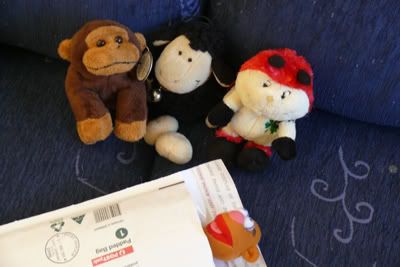
|
|
 Posted Aug 27, 2008, 3:22 am Last edited Aug 28, 2008, 7:11 am by sararingham
[Quote] [View just this post] Posted Aug 27, 2008, 3:22 am Last edited Aug 28, 2008, 7:11 am by sararingham
[Quote] [View just this post]

|
|
|
|
|
Eastern Finland, Finland - 4th September 2008
By: Hisch
Look, i just made some new friends 
The first picture show me with Felix (the bear), Alfred (monkey), Ivy (icebear) and Leonardo. Leonardo is hoping to start he´s journey into the big big world soon 
|
|
 Posted Sep 4, 2008, 6:13 pm
[Quote] [View just this post] Posted Sep 4, 2008, 6:13 pm
[Quote] [View just this post]

|
|
|



